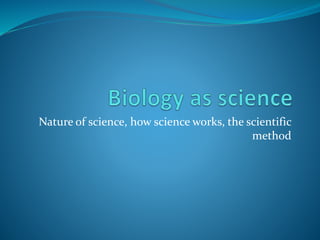
Biology as science
- 1. Nature of science, how science works, the scientific method
- 2. Nature of Science (NOS) Nature of science refers to general ideas and principles that describe what and how science is, and what are the essential characteristics of scientific knowledge. Scientific knowledge Non-scientific Studies only what can be observed, although intuition also helps scientist. (science has limits) Studies what cannot be observed Accepts the tentativeness of scientific knowledge, (inherently uncertain) Knowledge (ex. Religious faith) is absolute, (puts a premium on tradition) Scientific knowledge and results of scientific inquiry can be validated, ( it is result of a social process) Knowledge cannot be validated Observes critical thinking, evaluates the quality of information before making a judgement uses untested, unverified assumptions to make judgement Observes the scientific method Does not observe the scientific method
- 3. Science vs. non-science Science studies what can be observed directly or indirectly. Digestive system – first studied by William Beaumont (1785 – 1853) by observing the digestion through a hole (fistula) in a man’s stomach (Alexis St. Martin)
- 4. Science vs. non-science Science studies what can be observed indirectly. Theory of Evolution– Charles Darwin set in writing his theory of evolution in On the Origin of Species (published 1859). Theory of Continental Drift – Alfred Wegener proposed the theory that the continents once formed one continuous land mass (published 1912)
- 5. Science vs. non-science Evidence for Continental Drift Theory (1912) Presence of similar or identical species of organism on continents that are distance apart. Matching geology between separate continents
- 6. Science vs. non-science Science accepts the tentativeness of knowledge. Scientific knowledge is inherently uncertain and people with scientific mind accepts this to be so. Scientific models are based on facts which had been gathered. There could be “facts” out there for which we have no means to observe or get directly or indirectly. Ptolemic universe - Heliocentric - Finite and static universe -- Big Bang theory.
- 7. Science vs. non-science Studies done scientifically can be replicated and validated by other scientific studies. Science is a social activity. The Theory of Evolution by Natural Selection is continuously being validated everyday. (ex. Emergence of drug resistant bacteria, various breeds of dogs, etc.) The Theory of Relativity by Einstein (1905) was validated by Arthur Eddington and Arthur Claude de la Cherois in May 29, 1919. Light was validated to “bend”, gravity affect the “trajectory” of light.
- 8. Science vs. non-science Science observes critical thinking, does not accept untested assumptions. Examples of statements with questionable assumptions. Sir Pol has AIDS, therefore, Sir PoL is GAY. Cars can use water as fuel. Feng-shui- there is an appropriate design in architecture that harmonizes the forces in the environment.
- 9. Science vs. non-science Observes the scientific method.
- 10. Scientific Method The scientific method refers to a collection of techniques and strategies for investigating objects and phenomena, verifying claims, or acquiring new knowledge about the world. Its conclusions are based on empirical and measurable evidence. It is process of investigation. It evidence (facts) are empirical and measurable. Its goal is to reach a conclusion.
- 12. Scientific Method Problem/Question: Does drinking coffee (pure black, no cream, no sugar) regularly promote weight loss. Hypothesis: Regularly drinking pure black coffee promotes weight loss. Research: read about the published studies on coffee and weight loss.
- 13. Scientific Method Experiment: Design an experiment. Control group – drinks water regularly. Experimental group – drinks black coffee regularly Issues about experimental design: How many participants in each group? What is the baseline data about the weight of the participants? When is a change in weight significant?
- 14. Scientific Method Results: Analysis and interpretation of results based on the research/experimental design. Conclusion
- 15. Activity Think about five doable research problem. Problems that can be done in the university, using the resources we have in the laboratory. Research areas: Plant growth Performance in examinations Weight loss/weight gain Improvement in height
